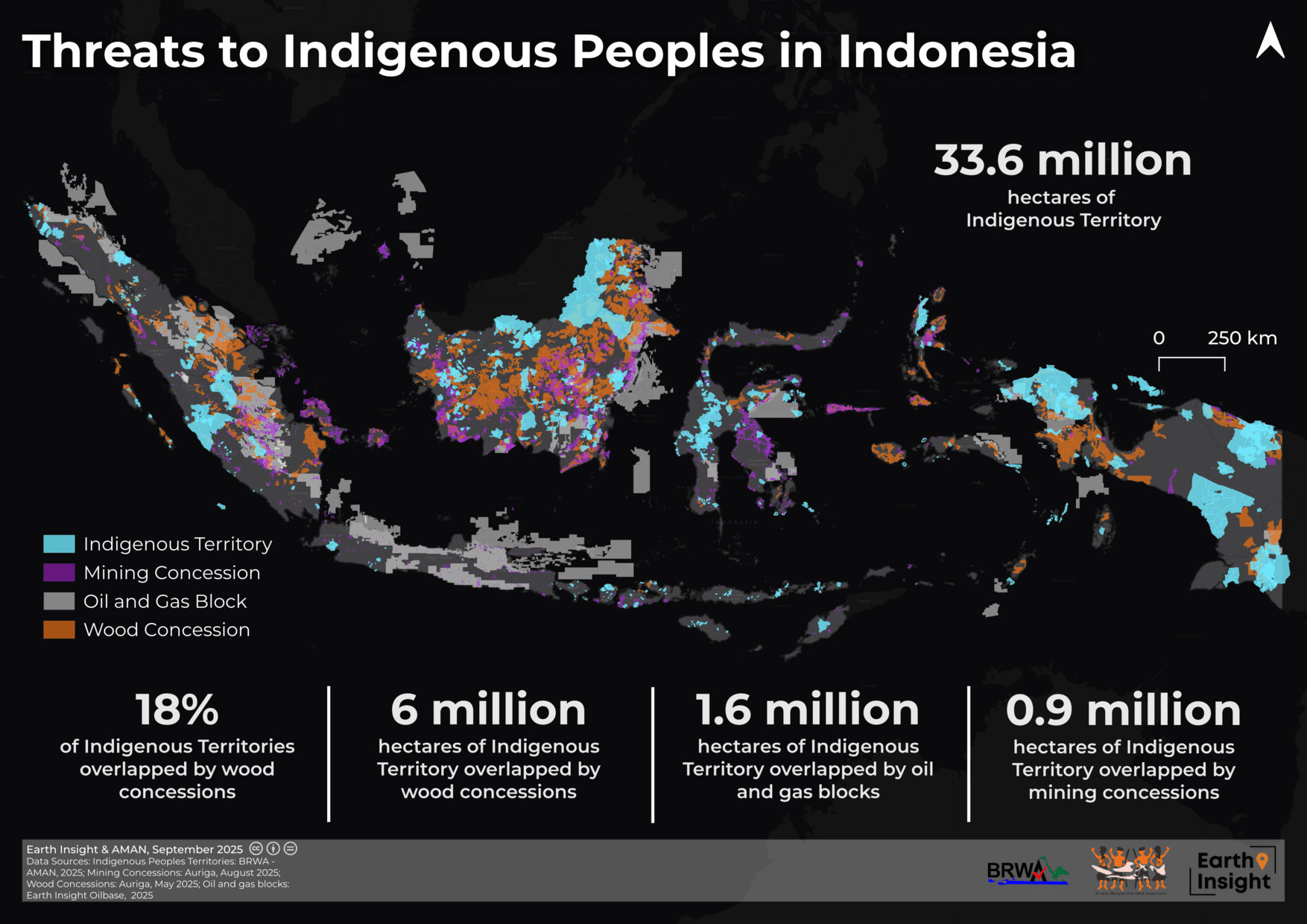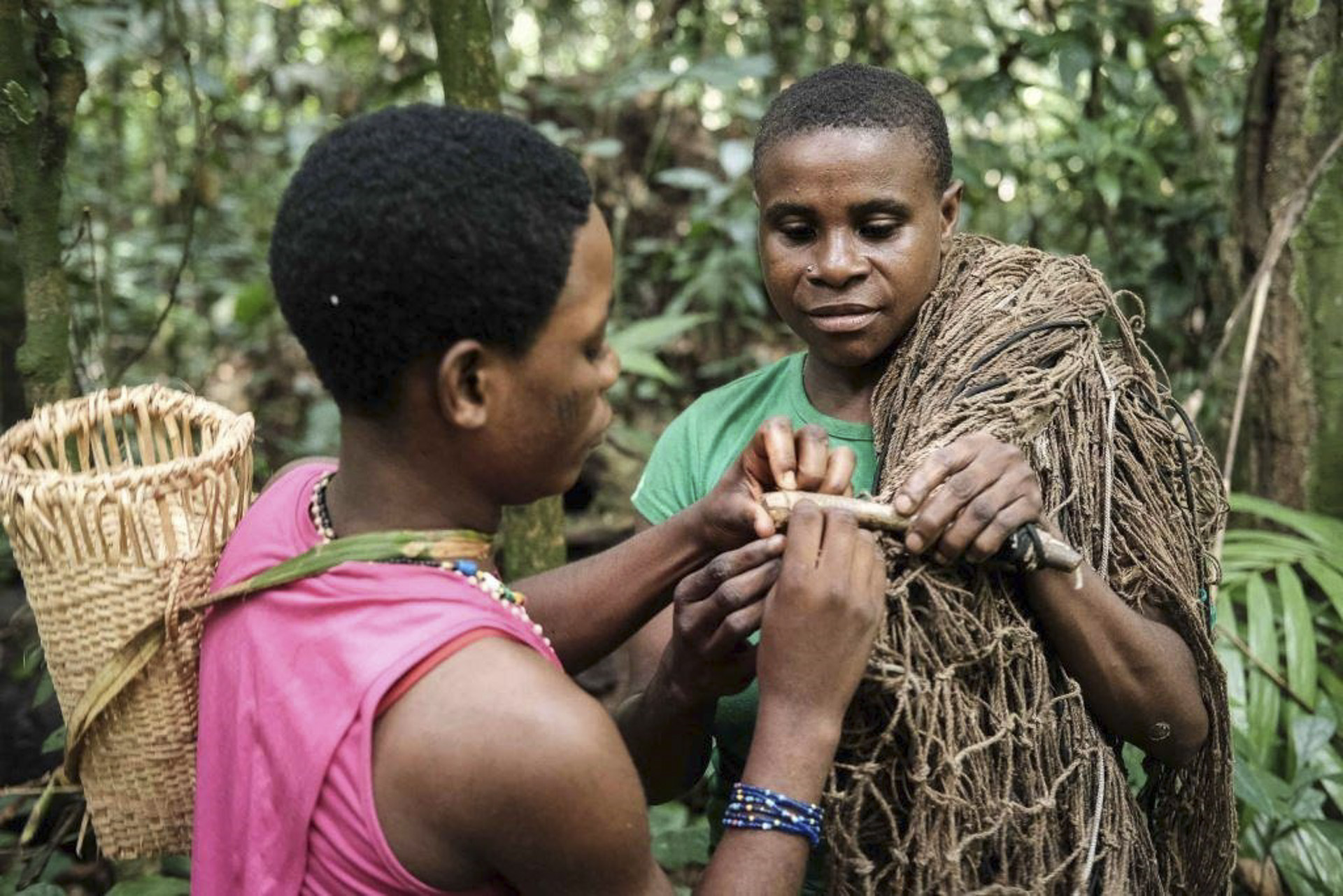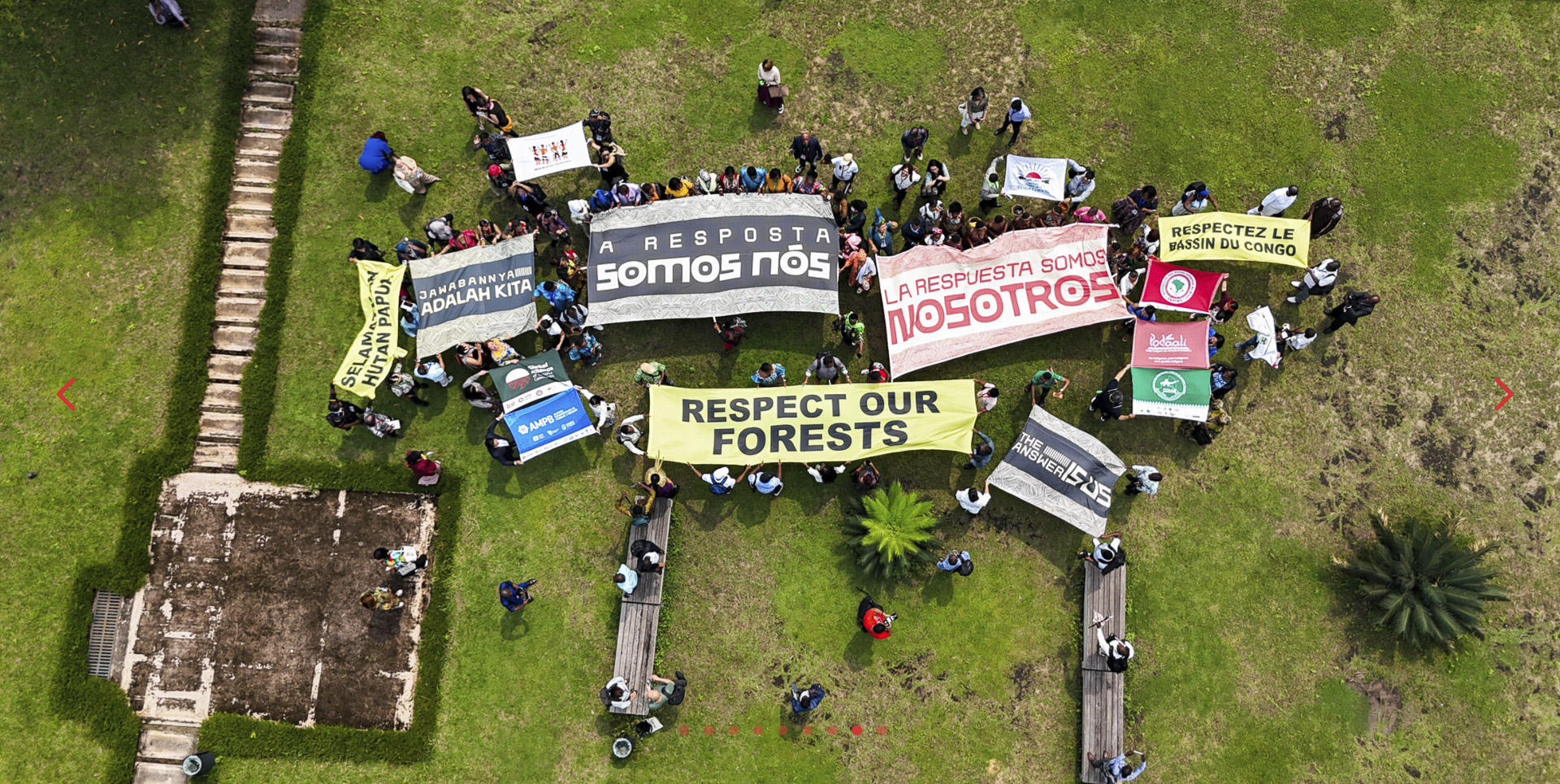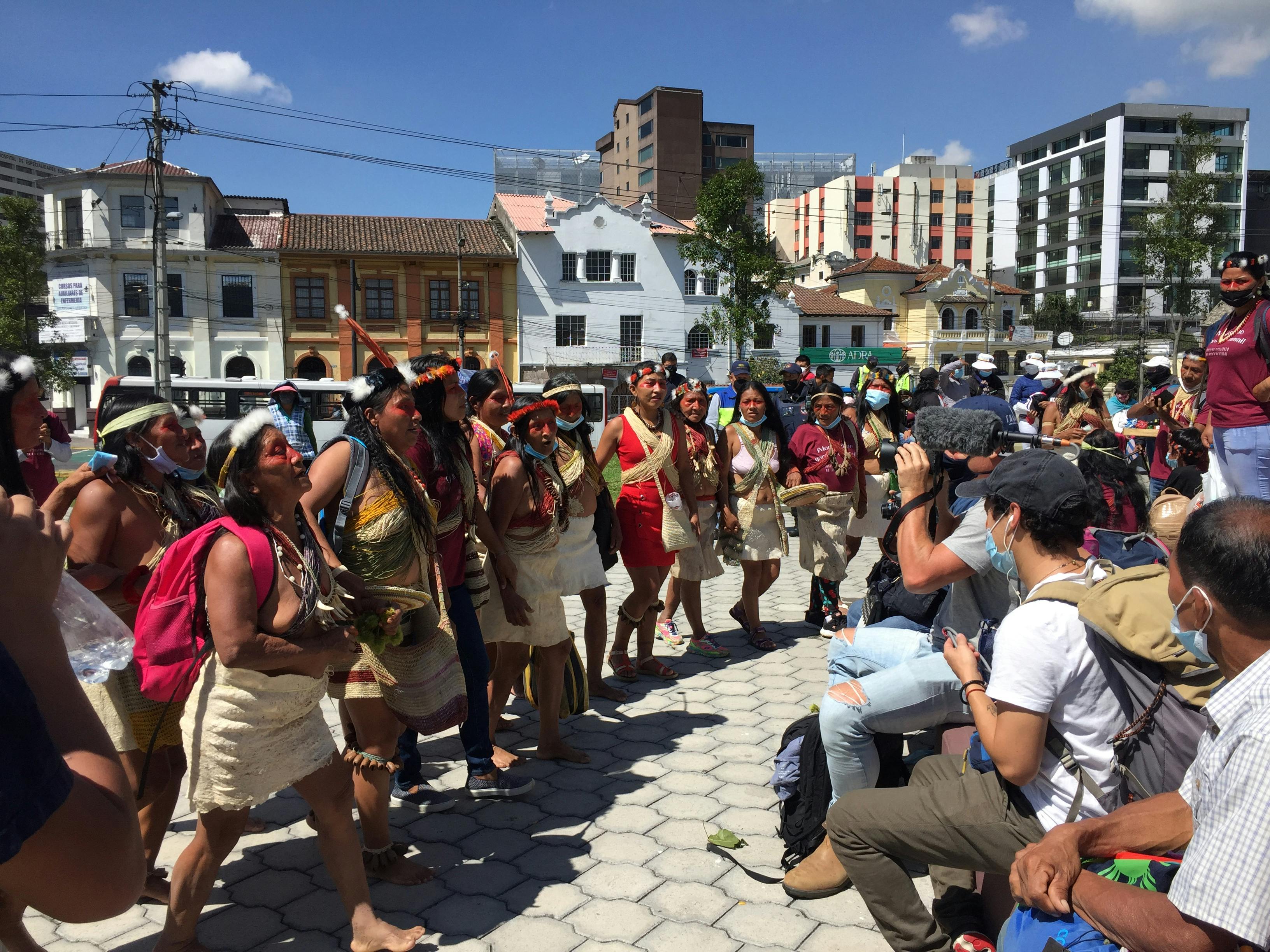Indigenous Peoples' Territories and Local Communities on the Frontlines
Read the Report in English Read the Summary in English Lea el informe en español - Amazonia Lea el informe en español - Mesoamerica Bacalah Laporan dalam Bahasa - Indonesia Lire le rapport en français - Congo Leia o relatório em português - AmazôniaThis report provides a comprehensive spatial analysis of extractive industry threats – including oil and gas, mining, industrial logging, and large-scale agriculture – facing Indigenous Peoples and local communities who steward nearly one billion hectares of the world's most critical forests.
Indigenous Peoples and local communities (IPs and LCs) steward nearly one billion hectares of tropical forests — lands that regulate the global climate, sustain biodiversity, and carry millennia of cultural and spiritual continuity. Though they represent less than 5% of the global population, they protect over half of the world’s remaining intact forests and nearly half of all Key Biodiversity Areas.
Yet, despite their proven stewardship, their territories are under unprecedented pressure. Across the tropics, extractive industries, agribusiness, industrial logging, and large-scale infrastructure—often framed as development or even “green transition” projects—are eroding ancestral lands, undermining climate stability, and threatening human rights.

Caption: The Sokoria geothermal power plant in Ende, East Nusa Tenggara, Indonesia. Image credit: Wiki Commons
A Landmark Global Analysis
The new report, “Indigenous Peoples’ Territories and Local Communities on the Frontlines,” co-created by GATC and Earth Insight, provides the most comprehensive spatial analysis of extractive threats and Indigenous-led solutions across four key tropical regions:
the Amazon, Congo Region, Indonesia, and Mesoamerica.
Together, these regions span 958 million hectares of forests and sustain the livelihoods of 36 million Indigenous Peoples and local communities. Combining geospatial analysis, community data, and case studies, the report maps both the magnitude of industrial pressure and the resilience of community-led solutions.

The Waorani indigenous people lead a demonstration in front of the Constitutional Court in Quito, Ecuador. Image credit: AP Photo/Dolores Ochoa
The Scale of the Crisis
Across all four regions, the findings reveal an alarming convergence of extractive pressures:
.png)
- Amazon: 31 million hectares (12%) of Indigenous territories overlap with oil and gas blocks, and 9.8 million hectares with mining concessions, exposing communities like the Waorani to pollution and displacement.
.png)
- Congo Region: 38% of community forests overlap with oil and gas blocks, threatening peatlands critical for global carbon storage.

- Indonesia: 18% of Indigenous territories are overlapped by timber concessions, while nickel extraction endangers the O’Hongana Manyawa, an Indigenous people living in voluntary isolation.
.png)
- Mesoamerica: Nearly 4 million hectares are encroached by oil and gas blocks and 19 million hectares (17%) by mining concessions — including in the Muskitia “Little Amazon,” where colonization and narcotrafficking drive deforestation.
These extractive pressures extend beyond land loss. Between 2012 and 2024, at least 1,692 environmental defenders were murdered or disappeared across GATC countries—208 linked to extractive industries and 131 to logging.
%20(1)%20(1).jpg)
Aerial view of peatland forest at Lokolama/Penzele around Mbandaka, Democratic Republic of the Congo. Image credit: Courtesy of © Daniel Beltrá / Greenpeace
Indigenous Leadership: Proven Solutions
Despite mounting threats, Indigenous Peoples and local communities continue to advance transformative, place-based solutions:
- In Indonesia’s Wallacea Archipelago, Gendang Ngkiong communities reclaimed 892 hectares of ancestral land through participatory mapping and legal reform.
- In Guatemala’s Maya Biosphere Reserve, community forest concessions achieve near-zero deforestation while sustaining local livelihoods.
- In Colombia, Indigenous Territorial Entities maintain over 99% of their forests intact across 36% of the Amazon.
- In the Congo Region, the landmark 2022 Pygmy Law set a precedent for inclusive governance and rights recognition.
Across regions, Indigenous stewardship consistently outperforms state and private management in preserving forests and ecosystems. But without legal recognition, protection, and direct support, these efforts remain precarious.

Image credit: Courtesy of REPALEAC
A Path Forward
The report echoes and expands the GATC’s Five Demands, reaffirmed in the Brazzaville Declaration, as a roadmap for global action:
- Secure land rights, the foundation for climate and biodiversity stability.
- Guarantee free, prior, and informed consent (FPIC) for all projects.
- Ensure direct financing reaches communities themselves.
- Protect defenders’ lives by ending violence and criminalization.
- Integrate Indigenous knowledge into climate, biodiversity, and development policy.

Image credit: The Answer Is Us - GATC
A Warning and an Invitation
This report is both a wake-up call and a call to action. Without urgent efforts to uphold Indigenous rights and support community-led stewardship, global climate and biodiversity goals will remain out of reach.
But by following the leadership of those who have protected these forests for generations, the world can chart a path from extraction to regeneration.
The future of tropical forests and of our shared climate depends on whether governments, funders, and institutions act on this knowledge.


